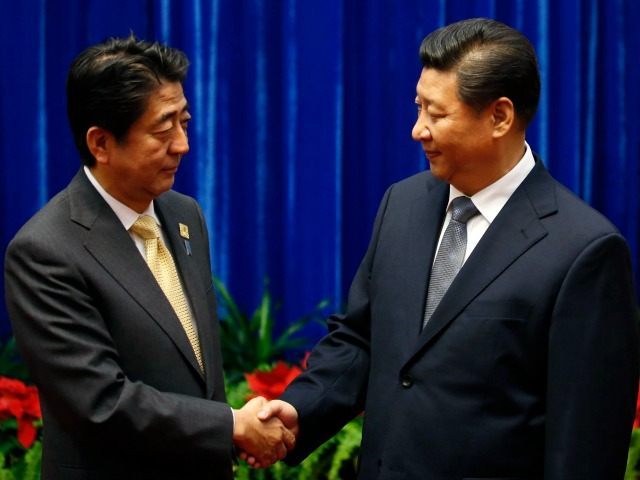On Saturday, Japan activated its first marine combat unit since World War II. China immediately panicked over the relatively small Japanese force, denouncing the revival of “militarism” under Prime Minister Shinzo Abe and advising every other Asian nation to go on “high alert” in the state-run Global Times.
The Global Times unloaded every criticism it could think of against the Japanese amphibious assault unit: questioning its legality under Japan’s pacifist constitution, portraying it as a threat to regional stability, blasting Japan for its reluctance to “sincerely apologize for war crimes,” ominously noting that Japanese schoolchildren are practicing a martial art called the “way of the bayonet” as part of their phys-ed curriculum, and questioning whether Prime Minister Abe has any business spinning up new military units when his political survival is threatened by a real-estate scandal tied to a “nationalist kindergarten where children are educated with a prewar style of militarism.”
If the 1,500 members of Japan’s new Amphibious Rapid Deployment Brigade (ARDB) are capable of threatening China or destabilizing the entire Pacific Rim, then they are formidable soldiers indeed. The Chinese are reacting with such hysteria to the formal inauguration of the unit because they know it is somewhat controversial in Japan, for precisely the reasons laid out in the Global Times editorial.
Chinese media coverage is hitting every pressure point it has detected in Japan’s political culture, where questions have been raised about whether the Self-Defense Force can develop aggressive force projection capabilities under the current constitution. The modestly-sized ARDB is not a huge problem in and of itself, but developing the transportation and combat support capabilities necessary to carry out amphibious assaults could pose a more serious challenge to Abe’s constitutional authority.
Abe really is in serious trouble over the land deal the Global Times alluded to. The Japanese Finance Ministry admitted on Monday that it actively participated in efforts to conceal the scandalous sale of property at steeply discounted rates to the Moritomo Gakuen school, leading to a fresh round of opposition calls for Abe’s resignation. Another document scandal rocked the Abe administration over the weekend related to logs tracking the activity of Japanese Ground Self-Defense Forces in Iraq in 2003.
Most observers of the Japanese political scene think Abe will likely survive the scandals, but public trust in his government has been eroded, and he and his party could face real trouble in the next election. China is doing what it can to stir the pot and exploit that loss of trust by questioning the legitimacy of Abe forming a new marine combat unit.
For the record, the Global Times is factually accurate but misleading about the resurgence of jukendo, the Japanese art of bayonet fighting. Until now, the vast majority of its practitioners have been members of the Self-Defense Force. It is now permissible to add jukendo to school physical education programs, but it is not required, and very few schools offer classes. The few that do have experienced some criticism about teaching such an offbeat martial art when styles like karate, judo, and kendo are vastly more popular.
Some of those critics sense a whiff of nostalgia for Imperial Japan in jukendo training, although its addition to the school curriculum was more a matter of jukendo enthusiasts in the Japanese military complaining that their preferred style was unfairly banned by previous school guidelines. At any rate, it is a pointless controversy because as noted American military expert Barack Obama explained in 2012, nobody uses bayonets anymore.
The primary reason China is so upset about the Amphibious Rapid Deployment Brigade is that every Japanese military officer, politician, and analyst has been quite clear their mission is to push back against Chinese imperialism in the South and East China Seas.
Japanese Defense Vice-Minister Tomohiro Yamamoto would not say whether the new brigade would be immediately dispatched to contested areas such as the Senkaku Islands, but the impressive demonstration staged by the unit made it clear their primary mission is “retaking remote islands that fall into enemy hands,” as Japan Times puts it.
“I believe the presence of the amphibious forces will work quite well against countries with any intention to make advances toward our territory,” retired Self Defense Force Lt. Gen. Koichi Isobe told Japan Times in another article about the ARDB.
In that piece, Japan Times stated that China’s “accelerating maritime expansion and tensions linked to its claim over the Japanese-controlled Senkaku Islands in the East China Sea” are pushing the Japanese government to develop stronger military options for the region.
The Chinese are very much aware that Japan can develop those options quickly, with its own industrial capacity and technological expertise plus assistance from the United States. China is currently spending over three times as much as Japan does on South and East China Sea military resources, but most analysts believe Japan could catch up to China’s capabilities within two years. It will now be important to see if Beijing declares the threat of resurgent Japanese militarism is so severe that it must step up its own military spending in response.

COMMENTS
Please let us know if you're having issues with commenting.